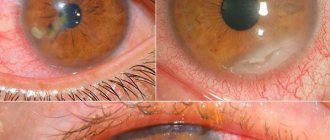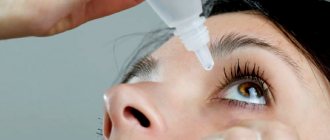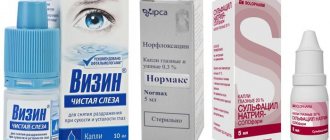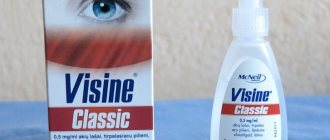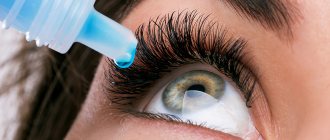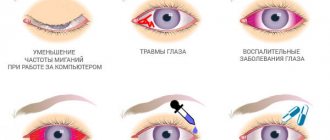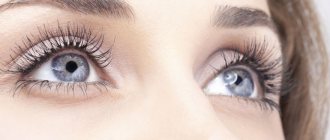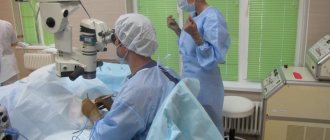Many people know firsthand what eye inflammation is. Regular work at the computer, colds, and exposure to microorganisms on the mucous membrane are fraught with complications. The eyes are constantly tense, which can cause redness, a burning sensation or itching, which become the main causes of inflammation.
In case of eye inflammation, it is very important to correctly determine which symptoms provoked this condition. And there may be a lot of them. Some of them can be classified as infectious, the rest as non-infectious. The effectiveness of treatment directly depends on the correct diagnosis and selection of therapy by an ophthalmologist. Inflammation of the mucous membrane of the eyes can be caused by various factors. So, for example, if it is a consequence of a cold, for example, ARVI, then, first of all, it is necessary to use medications prescribed by the therapist to treat the underlying illness, for example, antibiotics. However, you should not limit yourself to taking them. Our eyes are one of the main organs through which we receive information from the world around us, and therefore the ability to see clearly is very important. That is why, if you notice that your eye is inflamed, you need to make an appointment with an ophthalmologist. After conducting examinations, the specialist will prescribe you medications that can act directly on the source of inflammation. Typically, these medications are eye drops. Their advantage is that they are able to influence the visual organs, thereby eliminating discomfort in a short period of time.
Types of diseases
The causative agents of eye infectious diseases are various types of viruses, bacteria, fungi, and representatives of opportunistic microorganisms. Each of them has its own effect on the human body and is characterized by a different course of the disease.
Conjunctivitis
The disease is accompanied by enlarged, thickened vessels of the eye white, visible capillaries in the conjunctiva, overflowing with blood, mucous, mucopurulent and bloody discharge along the edge of the eyelids. Conjunctivitis can occur either in an acute form or become chronic. By origin they are:
- bacterial - nonspecific catarrhal, pneumococcal, diplobacillary, acute epidemic, diphtheria, gonococcal (gonoblenorrhea);
- chlamydial - trachoma, paratrachoma;
- viral - adenoviral conjunctivitis, epidemic keratoconjunctivitis, epidemic hemorrhagic conjunctivitis;
- allergic and autoimmune - hay fever conjunctivitis, vernal conjunctivitis, infectious-allergic conjunctivitis, conjunctival pemphigus.
Useful video
Viral conjunctivitis:
Barley
Accompanied by severe purulent inflammatory processes in the hair follicle or sebaceous gland at the base of the eyelashes, which can be caused by staphylococci. The redness that appears along the edge of the eyelid is accompanied by swelling, aggravated by pain and breaking through within a few days with the release of a purulent mass.
Blepharitis
This is the name for inflammation at the edges of the eyelids, which can last for quite a long time. Blepharitis can be caused by a variety of factors. The disease is provoked by vitamin deficiencies, anemia, diathesis, gastrointestinal problems, helminthic infestations, disorders in the endocrine system and metabolism, and diabetes.
Often accompanied by caries, chronic tonsillitis, polyps in the nasopharynx, adenoids. Common causes of the disease are staphylococci, streptococci, herpes simplex viruses, pathogenic fungi, and arthropods (Demodex mite).
The following varieties are found:
- Meibomian blepharitis is characterized by noticeable redness of the thickened edges of the eyelids, and in severe cases, loss of eyelashes. A foamy mass of a light shade collects in the corners of the eyes (secretion of the meibomian glands);
- during scaly blepharitis, small keratinized light gray lesions appear on the skin at the base of the cilia, separated from the epithelium; when they are removed, altered, thinned skin appears;
- Ulcerative blepharitis is usually detected in childhood and adolescence. Along the edge of the eyelid, at the base of the eyelashes, yellowish formations (dried purulent secretions of the sebaceous glands) are visible, connecting the hairs of the eyelashes in tufts. After the scales separate, bleeding ulcers appear along the edge of the eyelid. After scarring, deformed growth of eyelashes (trichiasis), changes along the edges of the eyelids, and inversion of the eyelids are noticeable.
Dacryoadenitis
An infectious disease occurs as a result of damage to the lacrimal glands by pathogenic microflora, which can penetrate from nearby inflamed organs: the parotid gland, maxillary sinuses and others in which there is chronic inflammation or an abscess. The disease is caused by both external (exogenous) and internal (endogenous) factors.
External factors:
- fungal infections of various origins;
- viruses of common diseases;
- bacteria (staphylococcus, pneumococcus, streptococcus, gonococcus, tuberculosis bacillus);
- infections caused by opportunistic microflora.
Internal factors:
- diseases of the body, circulatory and lymphatic systems;
- hormonal disorders;
- gland tumors.
Keratitis
The appearance of an infiltrate on the cornea, accompanied by a loss of its shine and a violation of transparency and specularity, is called keratitis. The epithelium at the site of the inflammatory process is disrupted and forms erosion.
Keratitis can be exogenous or endogenous, that is, caused by external or internal factors. They are divided into acute and recurrent, superficial and deep. The process may be accompanied by suppuration or proceed without it. By location they can be in the center or on the periphery of the eyelid.
Exogenous keratitis includes:
- corneal erosion;
- traumatic keratitis caused by mechanical, physical or chemical damage;
- infectious keratitis of bacterial origin (ulcerative);
- keratitis caused by diseases of the conjunctiva, eyelids, and meibomian glands;
- fungal keratitis;
- parasitic keratitis (acanthamoeba) - provoked by amoeba living in any environment.
Endogenous keratitis:
- infectious keratitis:
- tuberculosis (hematogenous and allergic);
- syphilitic;
- herpetic;
- neuroparalytic;
- avitaminous.
Types of drops
The modern pharmacological market offers a variety of eye drops. How to choose the right ones? Let's look at the drugs by category.
Antibiotics
Antibacterial drops are used for eye diseases caused by infection.
Sulfacyl sodium
This drug has a broad spectrum of action. It affects gram-positive and gram-negative bacteria, namely:
- streptococci;
- staphylococci;
- coli;
- pneumococci;
- gonococci;
- chlamydia.
Sulfacyl sodium is usually prescribed as part of complex treatment for conjunctivitis, blepharitis, chlamydial and gonorrheal lesions of the organs of vision.
Tsiprolet
This drug belongs to the antimicrobial drugs of the fluoroquinol group. The active ingredient of Tsiprolet is ciprofloxacin hydrochloride. Drops are used for a variety of eye infections, as well as to prevent complications after injury.
Tobrex
This is a broad-spectrum drug that belongs to the group of aminoglycosides. The main active ingredient is tobramycin. Tobrex is prescribed for the treatment of infectious eye diseases, such as keratitis, conjunctivitis, blepharitis, etc.
Levomycetin
This drug also has a broad spectrum of action; its active substance is chloramphenicol. Used for conjunctivitis, blepharitis, keratitis, if the pathogenic microorganism that caused them is sensitive to the drug.
Note! The use of Levomycetin drops is allowed in children from 1 month of age.
Anti-inflammatory non-steroidal
Medicines in this group relieve inflammatory processes and have an analgesic effect, which eliminates not only swelling of the eyes, but also other unpleasant symptoms.
Diklo-F
This medication is produced on the basis of diclofenac. It is used to eliminate swelling caused by infection, injury, or surgery. The maximum concentration of the active substance is observed 30 minutes after using the drops.
Indocollier
The main active component of these drops is indomethacin. Indocollir helps eliminate pain and inflammatory processes that cause swelling. The drug is suitable for long-term use, but not more than 1 month. It is usually used for the treatment and prevention of infectious diseases and allergic manifestations.
Hormonal (corticosteroids)
Cotricosteroid drops are usually prescribed for complicated infectious and autoimmune diseases. These are potent drugs that provide an almost immediate therapeutic effect. Hormonal drugs quickly relieve inflammation, pain, and signs of allergies.
Maxidex
This corticosteroid drug is made from dexamethasone. It is used for severe inflammation of a non-infectious nature, as well as allergic manifestations. The use of drops is appropriate when damage to the conjunctiva, anterior segment or cornea of the eye has occurred.
Betakortal
The main active ingredient of Betacortal is betamethasone disodium. The medicine has anti-inflammatory, anti-allergic and anti-escudative effects. Prescribed for severe symptoms of allergic and inflammatory diseases, both acute and chronic.
Diagnostics
If the symptoms of the disease do not disappear within several days, it is very dangerous to self-medicate. The best option is to consult an ophthalmologist.
During the initial examination, the specialist examines visual acuity using specialized equipment, checks the eyeball, fundus and cornea, and prescribes additional research methods, including taking cultures from the eye.
Histological, cultural, and molecular examination of smears is carried out. It is also necessary to study the sensitivity of microorganisms that cause the disease to antibiotics for further treatment.
When to use anti-inflammatory eye drops
The inflammatory process of the eyes most often develops in 2 cases: with allergic reactions and with infection.
Allergic diseases leading to eye inflammation:
- Reaction to insect bites;
- Drug allergies;
- Food allergies;
- Allergic reactions to various substances (pollen, animal hair, house dust, etc.).
Infections that require anti-inflammatory drugs:
- Blepharitis – inflammation of the eyelids;
- Conjunctivitis is inflammation of the outer layer of the eye;
- Keratitis – inflammation of the cornea;
- Dacryocystitis – inflammation of the lacrimal sac;
- Styes of the eye - inflammation of the hair follicle of the ciliary edge of the eyelid;
- Scleritis – inflammation of the sclera;
- Uveitis – inflammation of the choroid;
- Iridocyclitis – inflammation of the iris and choroid;
- Endophthalmitis is an infection of the internal media of the eye.
Treatment
After the studies, the ophthalmologist prescribes treatment, including both medications and home methods. Each type of eye infection requires a different regimen, which is selected by a specialist.
Pharmacy drugs
For incipient diseases, the drugs Albucid or Vitabact have a good effect.
For infections of viral origin, eye drops “Tobrex”, “Ophthalmoferon”, “Anandin”, tablets and ointments “Acyclovir”, “Acyclostad”, Zovirax”, “Panavir” are often prescribed.
For bacterial infections, including those caused by opportunistic microflora, ophthalmic drops against infections from the group of antibiotics are used. These include drops “Tobrex”, “Fucitalmic”, “Tsipromed”.
Tetracycline or Erythromycin ointments are often recommended. If necessary, the doctor prescribes oral antibiotics;
For fungal infections, drops with an antimycotic effect are prescribed: Fluconazole, Akromycin, Amphoteicin. Miconazole or Nystatin ointments are also used.
The patient undergoes regular antiseptic eye treatment to remove various infiltrates. To do this, with thoroughly washed hands, wipe each eye with a separate cotton pad with solutions of medications prescribed by the doctor.
It is necessary to treat the eyelids 3-4 times a day with a cotton swab, generously moistened with a disinfectant solution, and often rinse the conjunctival cavity with antiseptic solutions: nitrofural (furatsilin solution 1:5000), a slightly pink solution of potassium permanganate.
To strengthen the immune system, the doctor may prescribe multivitamin complexes.
Folk recipes
Traditional medicine is used in the complex treatment of eye diseases. As an independent remedy, they are ineffective.
Infusions of dill, chamomile, and freshly brewed tea are used as a means of removing keratinized particles and suppuration. For rinsing in the initial stage of the disease, it is good to use a decoction of oak bark, prepared from 2 tablespoons of raw material, boiled for 30 minutes in 0.5 liters of water. It is also used for compresses.
Homemade eye drops made from 2 parts cumin, 1 part cornflower petals and 1 part plantain leaves have worked well. Ground herbs are brewed in 1 cup of boiling water. The strained composition is consumed within 5 days.
Often in folk medicine, celery seeds are used, which are crushed and soaked for 4 hours in cold water. The strained product is used as drops.
REFERENCE. Very often in the summer, the eyes quickly get tired of bright sunlight and turn red.
Fill small gauze bags with flowers and immerse in hot water, let cool slightly, then apply to eyelids for 15–20 minutes. It is useful to alternate warm and cold compresses.
Prevention
The main means of preventing eye diseases is compliance with hygiene rules. It is very important to use an individual towel, handkerchief, and cosmetics. If necessary, touch your eyes only with thoroughly washed hands. When wearing contact lenses, monitor their condition and cleanliness, strictly follow the rules for their use and periodically take breaks from wearing them.
Eyes require protection from accidental contact with foreign substances during hazardous work. It is also important to wear sunglasses to protect from sun rays.
Expert opinion
Nosova Yulia Vladimirovna
Ophthalmologist of the highest category. Candidate of Medical Sciences.
An important factor in maintaining eye health is proper nutrition, containing sufficient amounts of vitamins and nutrients that help strengthen vision. To maintain the overall immunity of the body, it is important to adhere to a work and rest schedule, sufficient exposure to fresh air and regulated physical activity.
Considering that any disease can cause complications on other organs, it is always recommended to carry out thorough treatment until complete recovery . Regularly visit an ophthalmologist for a preventive examination, as well as if nonspecific sensations appear in the area of the visual organs.
A means of preventing healthy vision
The author of the recipe, Professor Filatov, advised regularly using the mixture for general strengthening throughout the winter, regardless of age category and health status.
0.5 kg of fleshy aloe leaves (removed carefully so as not to damage the plant trunk) are placed in thick paper or foil to prevent light from entering. There is no need to wash or cut the leaves.
Keep in the refrigerator for 2 weeks at a temperature of 3-5 degrees. Then the bag is taken out of the refrigerator, all prickly parts are removed, washed and ground through a meat grinder.
The resulting mass is mixed with 0.5 kg of good honey (if the honey has hardened, it is first softened by placing the jar in a water bath) and 0.5 liters of Cahors. Store the glass container tightly closed in the refrigerator. Take 1 tbsp of the mixture every morning on an empty stomach. spoon with warm water.
